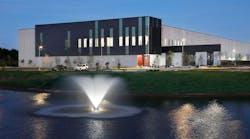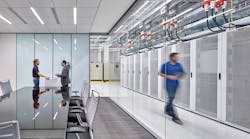There’s a major new player in the data center market, and its Uber.
The fast-growing ride-sharing company leased large chunks of “plug-n-play” wholesale space in three major markets during 2015, according to a new report from a data center real estate specialist. The burst of leasing comes just six months after Uber purchased a small data center from Microsoft, along with other assets that supported its mapping infrastructure.
Uber’s thirst for data center space illustrates the emerging demand from companies in two data-intensive sectors – connected cars and the peer-to-peer “sharing economy.” As these sectors mature, the leading players will be generating huge amounts of data, much of which must be managed in real-time systems spanning large geographies.
As its mission expands from ride sharing to a broader range of transportation logistics services, Uber is building out its data center network to support a global infrastructure.
According to a new market report from North American Data Centers, Uber has lined up large leases for data center space with Digital Realty in the Dallas and northern Virginia markets, while also procuring space with CoreSite in Silicon Valley. The leases, outlined were reported to range between 4 and 6 megawatts of IT capacity.
Building on Mapping Deal
Uber’s initial foray into the data center market came last June, when it acquired the mapping operations supporting Microsoft’s Bing Maps. The assets included software, cameras, and an image collection team of about 100 employees. Uber also acquired a data center near Boulder, Colorado that uses data center modules from Dell.
Uber has been rapidly expanding its business on all fronts – including employees, geographic markets and lines of business. The company now operates in more than 340 cities in 61 countries, and has grown to more than 4,000 employees, including an engineering staff of 900.
It no longer competes with just taxis, either. The UberRUSH service provides on-demand package delivery in San Francisco, Chicago and New York, while UberEATS delivers restaurant meals in 12 cities globally.
Uber’s Digital Domain
At the heart of all these services is a real-time data platform that manages a dynamic market that now spans six continents.
Uber engineers have spoken at length about the company’s software operations on the Uber Engineering Blog and conference presentations. But the privately-held company hasn’t revealed much about its data center network. While other emerging players in the sharing economy like AirBnB use the Amazon Cloud, Uber has taken a different approach. While it apparently does use AWS for some things, it operates its own data centers and also stores some data on its drivers’ mobile devices.
The company generates and manages large volumes of data, primarily to support its real-time dispatch system that matches drivers with riders using mobile phones. That requires real-time tracking of drivers in every city, accessing mapping and databases that span a huge global platform.
Drivers’ mobile phones send updates every 4 seconds as they move around. That’s why the design goal for Uber’s geospatial index is to handle a million writes per second, according to Matt Ranney, the Chief Systems Architect at Uber, in a recent presentation on scaling Uber’s market platform.
“Uber’s digital platform collects an incredible amount of data,” noted Tyler James Johnson at Convergent Technology Advisors. “Mapping information, our movements, preferences, connections are just a few of the elements in Uber’s data stores. This amount is massive, unique to Uber, and when combined creatively with other sources of data becomes a competitive weapon. Uber, like many others, is actively investing in developing additional capabilities, many of them digital. Data is the critical piece underlying that strategy.”
The Connected Car = Big Data
Uber provides an early example of the potential for connected cars to generate enormous volumes of data, which in turn will drive demand for data storage and data center space. Auto makers are expanding the data offerings on new models, going beyond on-board GPS navigation to provide safety and security apps (like “fatigue awareness” and stolen vehicle tracking, and even “infotainment” options.
Gartner forecasts that about one in five vehicles on the road worldwide will have some form of wireless network connection by 2020, amounting to more than 250 million connected vehicles. “The increased consumption and creation of digital content within the vehicle will drive the need for more sophisticated infotainment systems, creating opportunities for application processors, graphics accelerators, displays and human-machine interface technologies,” said said James Hines, research director at Gartner. “At the same time, new concepts of mobility and vehicle usage will lead to new business models and expansion of alternatives to car ownership, especially in urban environments.”[clickToTweet tweet=”Gartner: By 2020, more than 250 million vehicles worldwide will have a wireless network connection.” quote=”Gartner: By 2020, more than 250 million vehicles worldwide will have a wireless network connection.”]
As an example, the U.S. Department of Transportation is among those advancing a plan to make vehicle-to-vehicle (V2V) location awareness services standard in U.S. cars. “Our goal is to see this technology put in place as soon as possible. We know that it has the capability to help us avoid accidents that currently happen today,” Transportation Secretary Antony Foxx told CBS News. “We can expect the potential impact of up to 80 percent of crashes today avoided because of this technology.”
On the long-term horizon is the push for autonomous vehicles – cars that can drive themselves. Google is an early leader in this market, but Tesla, Ford, Apple and Baidu are also developing projects.
Not surprisingly, Uber is also a player in the potential autonomous vehicle market. The company has an Advanced Technologies Center it operates in conjunction with Carnegie Mellon University in Pittsburgh, where it conducts research and development on smart car technologies, including autonomous vehicles that would allow the company to reduce the cost to deliver its services.






